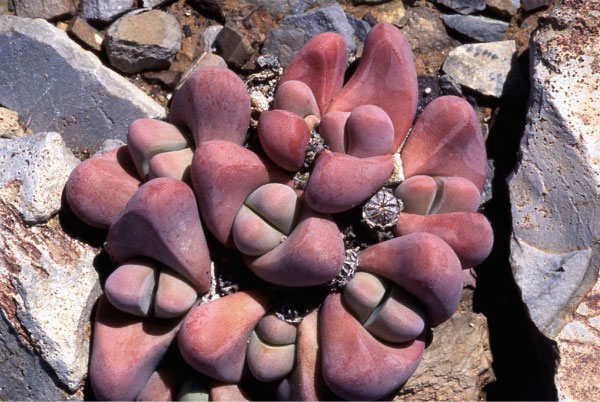The word Pleiospilos means ‘many spots’ which describes the species more than adequately. The sub-tribe Pleiospilinae used to contain a single genus Pleiospilos but now contains an additional genus Tanquana which consists of three species (see below).

Fig. 1 Pleiospilos compactus subsp. longibractus
They all have large fleshy leaves and large flowers which range from yellow to orange in colour which appear in the autumn. The genera are not difficult in cultivation, but very slow. Once they have reached flowering size they flower every year.

Fig. 2 Pleiospilos compactus subsp. peersii
Pleiospilos occur over a wide area of South Africa, some being found in central Bushmanland to the north with the largest occurrence in the Southern Cape. Tanquanas only grow in the Southern Cape in the arid Tanqua Karoo hence their genetic name.

Fig. 3 Tanquana hilmari
The genus consists of eight species, although the botanists have made it easier for the grower in that all but three species are now classified as sub-species of Pleiospilos compactus; so if you don’t know what you’ve got, call it Pleiospilos compactus, and you won’t be wrong in most cases.

Fig. 4 Tanquana prismatica
I grow my plants in a mix of small grit and John Innes no 3 and treat them as summer growing, starting the watering around April and continuing until October. I don’t water in the winter months.
Flowers usually appear around August opening around midday until the early evening.
I have grown Tanquana successfully using the same regime. Flowering is around the same time but the flowers are smaller. On my trips to South Africa I have seen two of the three species, namely Tanquana hilmari the most southerly growing of the three species, and Tanquana prismatica. This is the most distinctive of the species and tends to be widespread in the Tanqua Karoo forming clumps of some six inches in diameter which are reddish in colour. It usually grows in association with Didimaotus lapidiformis and Lithops comptonii. The other two species tend to be single bodied, hence difficult to see, hence my not finding the third species Tanquana archeri.
Eddy Harris
No part of this article may be reproduced without permission. Copyright BCSS & the Author 2020
